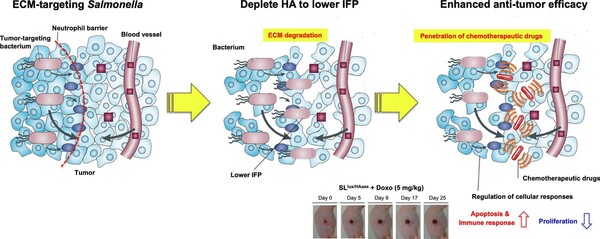Researchers at the Korea Research Institute of Bioscience and Biotechnology (KRIBB) developed a bacterial cancer therapeutic that increases drug permeability in cancerous tissues when combined with chemotherapeutic drugs.

Chemotherapy stops the growth of cancer cells which can be administered orally, infused, or injected. However, this therapy is usually limited as it can also damage normal cells, causing excessive secretion of cytokines.
Bacterial cancer therapeutics are being studied to reduce the toxicity to normal cells. For example, attenuated salmonella has a strong affinity for cancer tissues and can proliferate about 100,000 times more in cancer tissues compared to normal tissues as it can specifically target tumor cell substrates.
However, the anticancer substances contained in the bacteria cannot pass through the tumor extracellular matrix (ECM) surrounding the cancer tumor, so the efficiency of chemotherapy is still low.
Accordingly, the research team led by Professor Park Seung Hwan of KRIBB’s Biological Resource Center developed attenuated salmonella containing the HysA enzyme that can also decompose the tumor ECM, thereby enhancing the effectiveness of chemotherapy.
Consequently, the engineered Salmonella effectively degraded hyaluronan (HA), which is a major ECM constituent in tumors, and suppressed tumor growth in mouse models of pancreatic adenocarcinoma and breast cancer.
"By expressing tumor ECM-degrading enzymes on attenuated bacteria together with chemotherapy, we expect this study to overcome the limitations of tumor tissue drug permeability," Professor Park said. “We will contribute to the development of microbiome-based anticancer drugs by discovering excellent anticancer-targeting bacteria from the Korean microbiome bank."
The study was published as the cover for the March issue of the Journal of Controlled Release.

